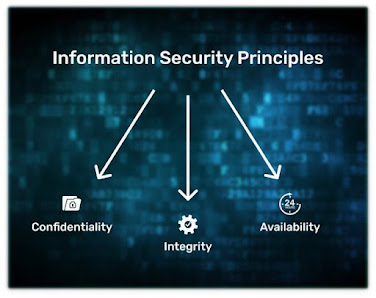Why is Information Security Important for IT Professionals?
Information security is of paramount importance for IT
professionals and the organizations they serve. In an increasingly digital and
interconnected world, the protection of sensitive data, the integrity of
systems, and the privacy of individuals are critical concerns. This article
explores the significance of information security for IT professionals, their
roles and responsibilities, and the broader implications for businesses and
society.
1. Protecting Sensitive Data:
One of the primary reasons information security is crucial
for IT professionals is to protect sensitive data. This includes personal
information, financial data, intellectual property, trade secrets, and any
confidential information an organization collects and stores. Unauthorized
access or breaches of this data can result in significant financial and
reputational damage.
IT professionals are responsible for implementing robust
security measures, such as encryption, access controls, and firewalls, to safeguard
data from cyberattacks and data breaches. Ensuring the confidentiality &
integrity of sensitive information is essential, not only for compliance with
data protection laws but also for maintaining trust and confidence among
clients and stakeholders.
2. Regulatory Compliance:
Numerous regulations and laws require organizations to
maintain the security of sensitive data. Non-compliance can lead to hefty
fines, legal consequences, and damage to a company's reputation. IT
professionals play a serious role in ensuring that their organizations adhere
to these regulations, which may include the Health Insurance Portability &
Accountability Act (HIPAA), the General Data Defence Regulation (GDPR), or the
Payment Card Industry Facts Security Standard (PCI DSS).
3. Business Continuity and Resilience:
A robust information security framework is essential for
ensuring business continuity and resilience. IT professionals must design and
implement disaster recovery plans, backup systems, and redundancy measures to
safeguard against data loss and system outages. These measures are crucial to
minimize downtime and financial losses in the occasion of a cyberattack or
natural disaster.
4. Protecting Against Cyberthreats:
Cybersecurity threats are ever-evolving, and organizations
are under constant attack from cybercriminals seeking to steal, manipulate, or
disrupt data and systems. IT professionals must continually stay abreast of
emerging threats and vulnerabilities, as well as implement the latest security
measures to protect their networks and data.
Common cyberthreats include:
Malware: Malicious software, such as viruses, Trojans, &
ransomware, that can infect systems and steal or corrupt data.
Phishing: Deceptive emails, websites, or messages designed
to trick users into revealing subtle information or downloading malware.
Distributed Denial of Service (DDoS) Attacks: Awesome a
network or website with traffic to disrupt its availability.
Insider Threats: Employees or other individuals with access to
an organization's systems who misuse their privileges to steal or compromise
data.
Social Engineering: Manipulating individuals into revealing
confidential information or performing actions that compromise security.
5. Ensuring System Integrity:
IT professionals are responsible for maintaining the
integrity of an organization's systems and networks. This involves ensuring
that software, hardware, and configurations are free from vulnerabilities and
that updates and patches are applied promptly. Neglecting system integrity can
leave an organization open to security breaches and compromise the reliability
of its technology infrastructure.
6. Protecting Intellectual Property:
In today's knowledge-based economy, intellectual property
(IP) is a valuable asset. IT professionals are entrusted with safeguarding an
organization's IP, which may include proprietary software, product designs,
research data, and business processes. Unauthorized access to this information
can result in financial losses and damage an organization's competitive
advantage.
7. Privacy Preservation:
Privacy is a fundamental right, and IT professionals must
uphold and protect the privacy of individuals. This is particularly relevant in
industries like healthcare and finance, where personal and sensitive
information is routinely collected and stored. IT professionals play a central
role in implementing privacy controls and encryption to prevent data breaches
and privacy violations.
8. Protecting Reputations and Trust:
A data breach or security incident can irreparably damage an
organization's reputation and erode trust among clients, partners, and
stakeholders. IT professionals are responsible for safeguarding an
organization's reputation by implementing rigorous security measures and
responding effectively to incidents. Restoring trust after a breach is often a
challenging and costly process.
9. Financial Consequences:
The financial implications of inadequate information
security can be severe. Data breaches can result in not only immediate
financial losses but also long-term legal costs, regulatory fines, and expenses
related to repairing damaged systems and compensating affected parties.
10. Ethical Considerations:
IT professionals have an ethical responsibility to protect
the systems and data they manage. Failing to do so can have ethical
consequences, including harm to individuals and organizations, and potential
legal and professional repercussions.
Conclusion
Information security is a critical consideration for IT professionals due to the numerous implications it carries, ranging from protecting sensitive data to ensuring regulatory compliance and safeguarding an organization's reputation. IT professionals are at the front lines of defending against an ever-evolving array of cyber threats, making their roles instrumental in preserving the integrity and security of digital systems and data. Whether in a corporate, government, or personal context, the importance of information security cannot be overstated, as it influences the safety, privacy, and trust of individuals and organizations in the digital age.


Comments
Post a Comment